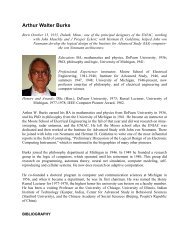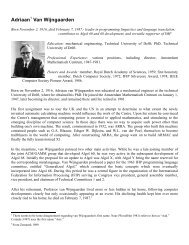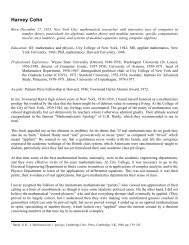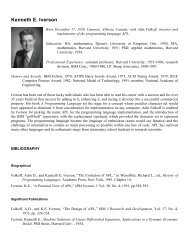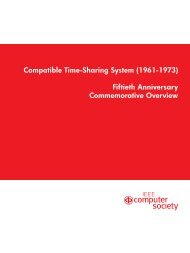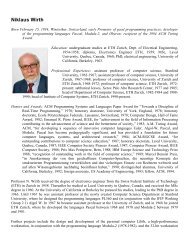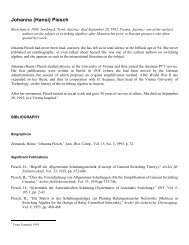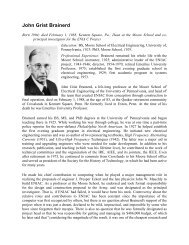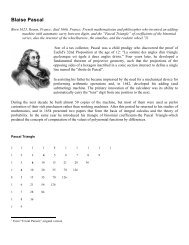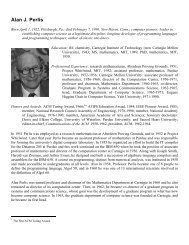You also want an ePaper? Increase the reach of your titles
YUMPU automatically turns print PDFs into web optimized ePapers that Google loves.
design of both the hardware and software of a large multiprocessing system. During this time <strong>Randell</strong> workedon dynamic storage allocation (with Carl Kuehner) and on system design methodology (with Frank Zurcher).In 1968 <strong>Randell</strong> was one of the group of IFIP Algol Committee members who resigned over Algol 68. Shortlyafterwards <strong>Randell</strong> took part in, and co-edited with Peter Naur the report on, the first NATO SoftwareEngineering Conference, an event which had a major effect on his future research thinking. These twoexperiences led to his involvement in the group that set up the IFIP Working Group on ProgrammingMethodology.In 1969 <strong>Randell</strong> returned to the UK to take up a position of professor of computing science in the ComputingLaboratory (now Department of Computing Science) of the University of Newcastle upon Tyne. Influenced nodoubt by his experiences at the NATO Conference, <strong>Randell</strong> set up a research project at Newcastle, funded bythe UK Science Research Council, and later also the Ministry of Defence, on Fault-Tolerant ComputingSystems.This research interest has continued ever since. In the early days of the research he investigated with colleaguesthe possibility of software fault tolerance, and introduced the “recovery block” concept. Subsequent majordevelopments have included, with Lindsay Marshall and others, the Newcastle Connection (a transparentlydistributed Unix system, developed in 1982) and, with John Rushby, the prototype Distributed Secure System,an architecture for multilevel secure systems, later taken up by the Ministry of Defence.Currently <strong>Randell</strong> leads the ESPRIT Basic Research Project on “Predictably Dependable Computing Systems.”This project, initiated in 1988, involves a number of the main European researchers who, like <strong>Randell</strong>, werefounder-members of the IFIP Working Group on Dependability and Fault Tolerance.In 1980 Lawford Russell's and <strong>Randell</strong>'s paths crossed again. By this time the former was technical director ofCAP, one of the major UK software houses. Together they set up MARI (the Microelectronics ApplicationsResearch Institute), a contract research, development, and training organization in Newcastle, jointly owned bythe university, CAP, and Newcastle Polytechnic. <strong>Randell</strong> remained an associate director of MARI for some 10years, until it became an independent organization with over 300 staff, involved in a large number of Europeancollaborative research projects.<strong>Randell</strong>'s other research interest is the history of computing. He first started to pursue this interest actively soonafter he reached Newcastle, prompted by his coming across the work of Percy Ludgate, the little-known Irishcomputer pioneer, while <strong>Randell</strong> was preparing material for his inaugural lecture. The main results of thisresearch interest have been the book that <strong>Randell</strong> edited entitled The Origins of Digital Computers, and hisunveiling of the Colossus machines-code breaking computers that were developed secretly in the UK duringWorld War II. 1Since arriving at Newcastle, <strong>Randell</strong> has had brief sabbaticals and visiting professorships at the University ofToronto, Canada, the University of Otago, New Zealand, the Universities of Kaiserslautern and of Karlsruhe,Germany, and CNRS-LAAS, Toulouse, France.1 See the biographies of I. J. Good, Max Newman, Donald Michie, and Alan Turing.
BIBLIOGRAPHYSignificant PublicationsNaur, P., and <strong>Brian</strong> <strong>Randell</strong>, eds., Software Engineering-Report on a Conference Sponsored by the NATOScience Committee, Garmisch, Germany, 7 to 11 October, 1968, NATO Scientific Affairs Div.,Brussels, 1968.<strong>Randell</strong>, B., and L. J. Russell, Algol 60 Implementation, Academic Press, London, 1964. (Russian translationpublished by the State Publishing Organization, Moscow, 1967).<strong>Randell</strong>, B., and F.W. Zurcher, “Iterative Multi-Level Modelling: A Methodology for Computer SystemDesign,” Proc. IFIP Congress 68, North-Holland, Amsterdam, 1968, pp. D138-142.<strong>Randell</strong>, B., “A Note on Storage Fragmentation and Program Segmentation,” Comm. ACM, Vol. 12, 1969, pp.365-369.<strong>Randell</strong>, B., Origins of Digital Computers: Selected Papers, 3rd ed., Springer-Verlag, Berlin, 1982.<strong>Randell</strong>, B., and J. J. Horning, “Process Structuring,” Computing Surveys, Vol. 5, No. 1, Feb. 1974, pp. 69-74.<strong>Randell</strong>, B., “System Structure for Software Fault Tolerance,” Proc. Int'l Conf. on Reliable Software, reprintedin Trans. Software Engineering, Vol. SE-1, No. 2 June 1975, pp. 220-232.<strong>Randell</strong>, <strong>Brian</strong>, “Colossus: Godfather of the Computer,” in <strong>Randell</strong>, <strong>Brian</strong>, Origins of Digital Computers:Selected Papers, Springer-Verlag, Berlin, 1977, pp. 349-354.<strong>Randell</strong>, B., “The COLOSSUS,” in Metropolis, N., et al., eds., A History of Computing in the TwentiethCentury, Academic Press, New York, 1980, pp. 47-92.<strong>Randell</strong>, B., D.R. Brownbridge, and L.F. Marshall, “The Newcastle Connection, or, Unixes of the WorldUnite,” Software Practice & Experience, 1982, pp. 1147-1162.<strong>Randell</strong>, B., and J.M. Rushby, “A Distributed Secure System,” Computer, July 1983, pp. 55-67.<strong>Randell</strong>, B., and R.H. Campbell, “Error Recovery in Asynchronous Systems,” IEEE Trans. SoftwareEngineering, Vol. SE-1 2, No. 8, Aug. 1986, pp. 811-826.<strong>Randell</strong>, B., J.P. Black, and L.F. Marshall, “The Architecture of Unix United,” Proc. IEEE, Vol. 75, No. 5, May1987, pp. 709-718.<strong>Randell</strong>, B., and J.E. Dobson, “Formal Verification: Public Image and Private Reality,” Comm. ACM, Vol. 32,No. 4, Apr. 1989, pp. 420-422.UPDATESPortrait changed (MRW, 2013)





